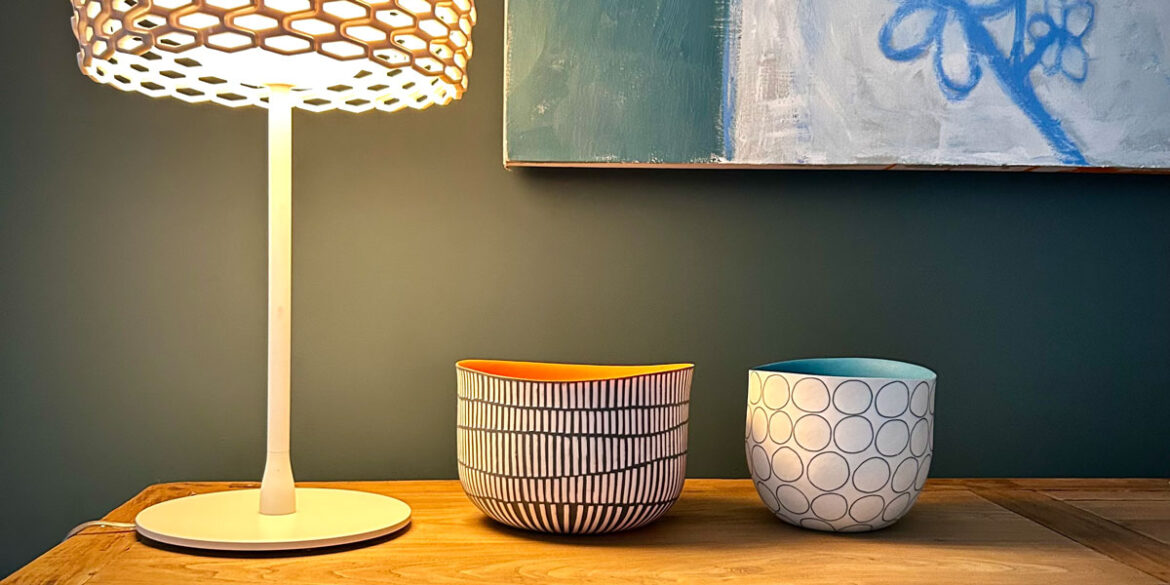Advertising feature
Illuminate your home to create warm and inviting spaces that combat seasonal darkness and enhance mood, says Catherine Harhalakis
For me the winter months are all about embracing the seasonal change and making sure that there is a thoughtful approach to the lighting in our homes. As the days grow shorter lighting design is crucial during these months to transform our living spaces from cold and stark to comfortable and welcoming.
Creating layers of light is key. Each room needs its own approach, using a balance of different types of lighting – pay attention to the function of the room, how much natural light it gets, and its decorative style. The lighting plan for a kitchen or bathroom is very different from a living room or bedroom.

Reflective wallpaper can boost light levels in a north-facing room

Warm-toned task lighting in the bathroom adds to the layering effect
The layers can be broken down into three main areas: ambient, task and accent lighting. Ambient lighting provides overall illumination through ceiling fixtures, track lighting or recessed lights. Task lighting is more focused, illuminating specific activities such as reading lamps, desk lamps, under-cabinet kitchen lights or pendants over a kitchen island; adjustable options allow you to direct light precisely where you need it. Accent lighting provides atmosphere and depth, lighting that highlights architectural features or artwork, such as wall lights, picture lights, strategically placed lamps.
Table and floor lamps are my favourites. They’re decorative and beautiful to look at, as well as providing a mid-level layer of light and glow. They can be positioned in different parts of a room, used to light up dark areas and also positioned behind a sofa or armchair for reading. A glossy ceramic or a glass lamp base will reflect light too. Think about the type of shade and the lining – is it opaque or translucent? – because this will affect whether the light filters out or whether it glows.
Window treatments
Think about how the natural light informs a space. In darker, north-facing rooms consider incorporating high gloss, metallic or lacquered surfaces that will reflect and help to lift light levels. A well-placed mirror can bounce light around a room. It will make the space feel larger and brighter on dark winter days.
Maximising the amount of light that comes into a space is important but so is how you choose to dress a window. In winter, undressed windows become harsh, dark surfaces. Being able to cover them with curtains or a blind in a beautiful fabric with pattern or texture adds another layer of comfort and also warmth to the room.
Think about the positioning of the curtain or blind too. If you have space, fit the pole so the curtains can draw back beyond the window. Similarly, with roman blinds, if possible install them above the window so they draw up without blocking any daylight.
Lighting tips
- Fit multiple lamps to a 5amp circuit, to control them all from one switch
- Dimmer switches allow you to have well-lit and low-lit spaces in the same room
- Consider the colour and the wattage of light bulbs. Use higher wattage bulbs for task lighting and lower wattage in lamps
- Light colour is measured in kelvins – the higher the ‘colour temperature’ the whiter it looks. In traditional homes, 2,700k is popular; in contemporary spaces go for 3,000k
- Trimless downlights can be plastered into the ceiling and are neat and unobtrusive. Think about the room’s layout and try to locate them where they’re needed, rather than in a grid across the ceiling
- LED light strips can recessed into shelving, architraves and skirting boards to accentuate the clean lines of a room

